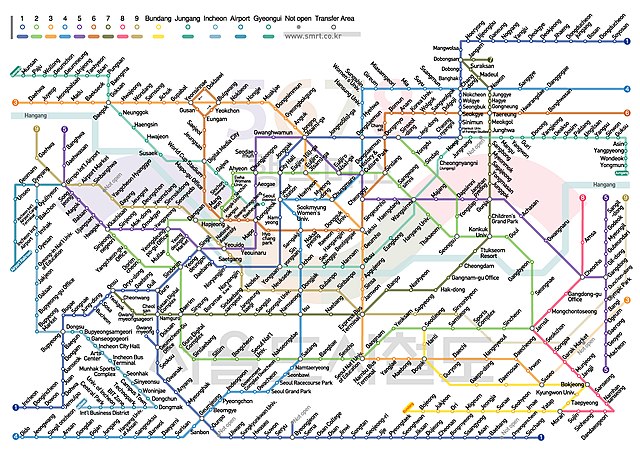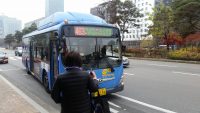Transit Report Card: Seoul

wikimedia
Last week I attended a conference in Seoul. After long days of, uh, conferring, I wandered the subways and streets of one of the largest Asian megacities.
Myeongdong
For a great walking city, Seoul is a curiously bad walking city. Things are close together, and the side streets are narrow enough to be dominated by pedestrians (see above). But when there's an arterial, you get something like this:
Yeouido, by the park. Not a crosswalk to be seen.
I would have been remiss to skip Cheonggyecheon, the famous (in Seattle) site where a stream replaced an elevated freeway. I happened to be there during the Lantern festival, when it was swarming with people.
During the day, with fewer people (and away from the lanterns).
It's a welcome spot of green space in a city with much smaller oversupply of it than Seattle.Lines Ridden: 1 thru 6, 9, Gyeongchun Line (not depicted above) the Airport express; 3 bus lines.
Fare Structure and Payment: A-. Fares are 1250 Won, or just over a dollar, pretty much across the board, while Korea isn't that much poorer than the United States. T-Money cards (ORCA equivalents) are available at most convenience stores, and can be used for lots of things besides transit. Unfortunately, those codes must be loaded at stations, using machines that only take cash.
People also pay by phone.
Speed: A. There are lots of stops, but it reasonably fast given that.
Reliability: A+. I never had the sensation that trains stopped due to any kind of congestion. Seoul's streets are, curiously, not overloaded, so the buses run pretty well.
 Frequency and Capacity: B+. I had the great misfortune of staying on Line 9, at a stop that was skipped by every other (express) train. It meant that headways could exceed 10 minutes, unlike other lines. The trains go on forever, and we never had a push-the-people-into-the-door situation. I didn't use buses extensively, but never experienced a headway more than 15 minutes, and usually about 10.
Frequency and Capacity: B+. I had the great misfortune of staying on Line 9, at a stop that was skipped by every other (express) train. It meant that headways could exceed 10 minutes, unlike other lines. The trains go on forever, and we never had a push-the-people-into-the-door situation. I didn't use buses extensively, but never experienced a headway more than 15 minutes, and usually about 10.
Scope: A. It goes everywhere, and even has quite long tendrils into the suburbs.
Span of Service: B. 5:30am to midnight every day, for a city that definitely runs beyond that.
Wayfinding: A. Signs were clear and in English. Like Tokyo, Seoul numbers its station exits, which allows attractions to give better directions and make exit from labyrinthine stations more efficient.
Accessibility: B. There were elevators pretty much everywhere, but the stations themselves spread out, with long tunnel excursions to get from one platform to the next.
Safety: A. Seoul is a very safe city.
Stations: B. Again, the stations wouldn't have to require quite so much walking with a little more design foresight. The saving grace was that those walking spaces were filled with commerce.

Gangnam Station, 6pm